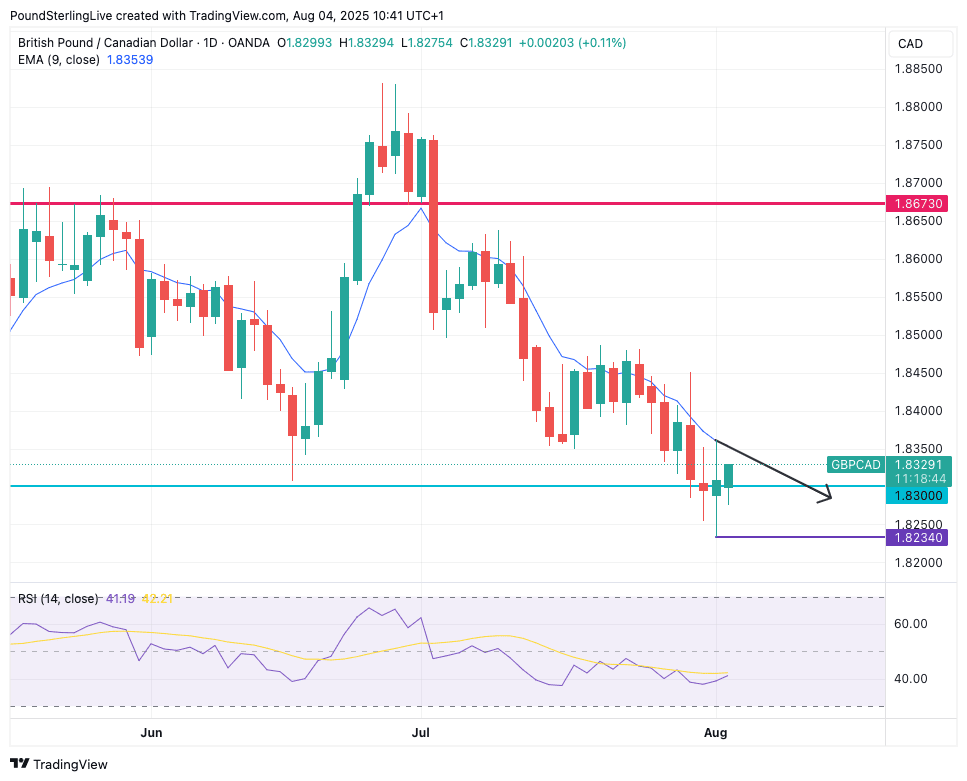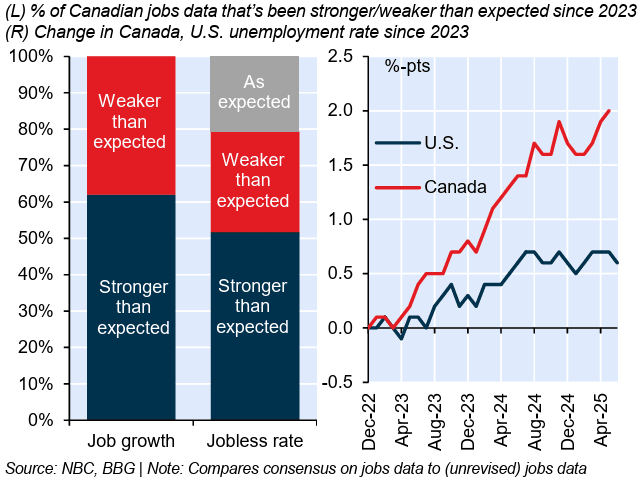
Image © Adobe Stock
It's too soon to call the end of the GBP/CAD decline.
The Pound to Canadian Dollar exchange rate (GBP/CAD) is rising back to its nine-day exponential moving average (EMA) at 1.8353 as part of a consolidative move within the auspices of a month-long downtrend.
Some near-term gains are possible, but while capped below the nine-day EMA, the short-term trend remains lower. This is why we look for the near-term recovery to ultimately evolve into a retest of the 1.8234 lows in the coming days.

Above: The nine-day EMA (blue line) is pointed lower and is dictating the general short-term trend.
GBP/CAD rose on Friday in line with a recovery in GBP/USD - the two pairs are now closely correlated - that followed a soft U.S. jobs report.
Therefore, the coming days for GBP/CAD could depend on how GBP/USD evolves from here: does it shake off the weaker-than-forecast labour market statistics or do the numbers serve as a reminder that there is good reason to rebalance global portfolios to avoid over-reliance on the U.S.?
The latter is the foundational driver of the USD's weak performance in 2025, which has in turn weighed on the CAD.
The trade has taken a breather of late, which explains GBP/USD and GBP/CAD's decline in July. As we enter the second half of the year we are at a point of flux for a market that is trying to determine whether the 'sell America' trade is justified or was an overreaction to U.S. President Donald Trump's policy changes.
"If weakness in activity data in sustained going forward, it will make markets question the recent outperformance in US equities on the back of trade deal announcements that has been lifting the USD relative to peers," says a note from TD Securities.
Should subsequent data corroborate last week's soft U.S. payroll figures we saw on Friday, then the 'sell America' trade could evolve a second leg that would help lift GBP/CAD back to the 2024 highs at 1.8450.
For now though, the technicals tell us GBP/CAD is in a short-term downtrend, and we will respect this by awaiting further weakness and staying alert to any developments that would signal the downtrend is ending.
The week's calendar provides some interest for us in the form of Canadian job market figures, due Friday. Here, markets look for 15.3K jobs to have been added in July, down from 83.1K in June.
An undershoot would bolster bets the Bank of Canada will cut interest rates again, potentially weighing on CAD ahead of the weekend.

Above: Canadian job reports have tended to deliver upside surprises relative to consensus. Image courtesy of NBC.
The Canadian figures will come just 24 hours after the Bank of England cuts interest rates and releases new forecasts and guidance. The cut itself won't be controversial as it is well anticipated, and should offer GBP/CAD very little stimulus.
We are more interested in how the forecasts evolve: for instance, are the medium-term inflation forecasts lowered or raised? This will be crucial in determining how guidance on the future of interest rate policy evolves.
For instance, an upgrade to forecasts would prompt the Bank to condition assumptions that Bank Rate cannot fall as far as previously assumed, and that caution must be the word of the day.
This would amount to a somewhat 'hawkish' policy decision that would bolster GBP across the board, particularly given the context of a market that has been pricing in more by way of rate cuts over the course of July.
However, a lower inflation forecast profile, accompanied by guidance that the Bank stands ready to cut interest rates to underpin a deteriorating labour market, would certainly weigh on GBP/CAD.
Under such a scenario, we would anticipate a move to 1.8234 and even below, which would take the exchange rate to a series of successive new four-month lows (provided the Canadian jobs report on the following day is firm).
